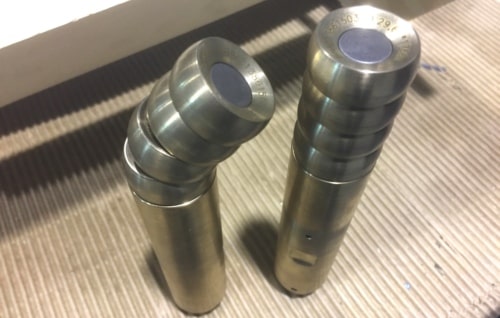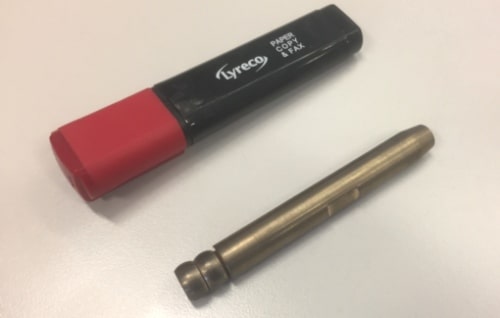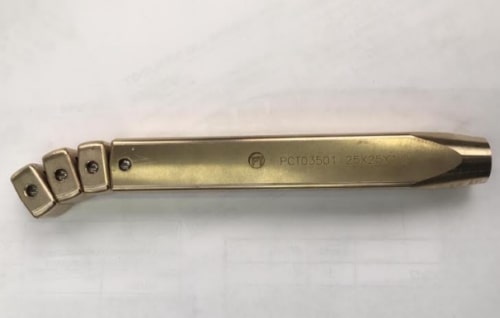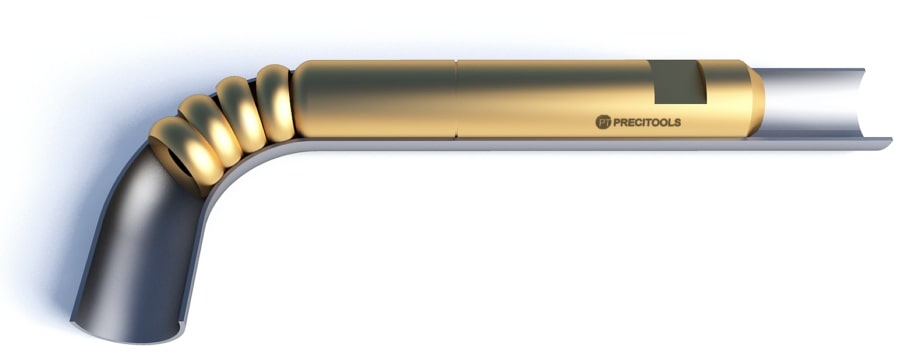Mandrel bending technology

Mandrel is one of the main elements for tube bending and machines to work with mandrel are called "mandrel tube bending machines". There are other machines called "mandreless" which means that they cannot use mandrel.
Mainly historically bending of tubes were performed with filler, usually sand. Sand was filled inside the tube, both ends welded or plugged and after the bending was perfomed. Mandrel plays a role of the filler in tube bending technology and helps to make more controlled deformation and prevent the problems and ovality of tube after the bend. Also mandrel stabilizes the tube pressure of external wall during the bending process.
Position of mandrel is adjusted on tube bending machine and various types help to perform even very complicated bends, thin wall tubing, small radiuses and hard materials. Important also to note that the bending with mandrel is used in "draw bending" tube technology.
Based on various tube materials different material of mandrels is used. Today for technology and all the producers for all hard materials such as stainless steel mandrels made of aluminium-bronze alloy are used.
Mainly historically bending of tubes were performed with filler, usually sand. Sand was filled inside the tube, both ends welded or plugged and after the bending was perfomed. Mandrel plays a role of the filler in tube bending technology and helps to make more controlled deformation and prevent the problems and ovality of tube after the bend. Also mandrel stabilizes the tube pressure of external wall during the bending process.
Position of mandrel is adjusted on tube bending machine and various types help to perform even very complicated bends, thin wall tubing, small radiuses and hard materials. Important also to note that the bending with mandrel is used in "draw bending" tube technology.
Based on various tube materials different material of mandrels is used. Today for technology and all the producers for all hard materials such as stainless steel mandrels made of aluminium-bronze alloy are used.

We can offer mandrels even for 9-10 mm internal diameter of tube till the most bigger sizes more than 200 mm.
In general the correct offer for mandrel values a lot, on this page you will find general theoretical recommendations, meanwile the most efficient way is based on tests and probably even try of different constructions to achieve the better result together with fine adjustment of all other positions of tools and travels of tube bending machine.
Also the quality of the final parts depends of the application, in furniture 30% of ovality could be normal and in aerospace even 5% values and should be critical. Because the mandrel is weared during the bending process the construction of mandrel is also very important - the possibility to replace single balls and internal connectors allows not to request the complete replacement of the full part.
For precision tube bending the body and balls are made with 0,1-0,2 gap of the tube size, which means for 16 mm internal diameter of tube the diameter of mandrel body could be 15,8 mm. Normally we are offering our standard recommendations, anyway the customer is able to request the sizes he wants.
Mandrel is the tooling we can offer for ANY machine without drawings. To make the correct request you just need to specify
 Tube outer diameter
Tube outer diameter
 Tube inner diameter or wall thickness
Tube inner diameter or wall thickness
 Material of tube
Material of tube
 Radius of bending
Radius of bending
 Thread size and type (internal / external)
Thread size and type (internal / external)
 Specified length if necessary
Specified length if necessary
In general the correct offer for mandrel values a lot, on this page you will find general theoretical recommendations, meanwile the most efficient way is based on tests and probably even try of different constructions to achieve the better result together with fine adjustment of all other positions of tools and travels of tube bending machine.
Also the quality of the final parts depends of the application, in furniture 30% of ovality could be normal and in aerospace even 5% values and should be critical. Because the mandrel is weared during the bending process the construction of mandrel is also very important - the possibility to replace single balls and internal connectors allows not to request the complete replacement of the full part.
For precision tube bending the body and balls are made with 0,1-0,2 gap of the tube size, which means for 16 mm internal diameter of tube the diameter of mandrel body could be 15,8 mm. Normally we are offering our standard recommendations, anyway the customer is able to request the sizes he wants.
Mandrel is the tooling we can offer for ANY machine without drawings. To make the correct request you just need to specify
 Tube outer diameter
Tube outer diameter Tube inner diameter or wall thickness
Tube inner diameter or wall thickness Material of tube
Material of tube Radius of bending
Radius of bending Thread size and type (internal / external)
Thread size and type (internal / external) Specified length if necessary
Specified length if necessary
Types of mandrels

MAN-F: Solid mandrel flat nose

MAN: Solid mandrel classic shape

MAN-R: Solid mandrel rounded nose (US style)

MAN-PL: Solid mandrel with 1 side shape

MAN-1B: 1-ball mandrel classic

MAN-1BS: 1-ball mandrel spheric

MAN-MB: Multi-ball mandrel classic

MAN-MB-SP: Multi-ball mandrel with small pitch
Multi-ball mandrels could be also called "flexible" mandrels

Why mandrel is so important?
Generally mandrel is considered as the element for use for any tube bending less than 3D (which means radius of bending on centerline Rm is less than 3 outer diameter of tubes (for example for tube OD 16 mm Rm is less than 48 mm. Anyway even for bigger radiuses mandrel is the element to make the quality of bend better.
Possibility of mandrel or use of mandrel tube bending machine is the only one active technology for most of bends and used in all industries. Moreover as we already told it depends of the appliccation - for example for any fluid or air tubes with pressure the quality of bend is very important.
Quality of bended tubes (outside of question of final geometry) are based on quality outside the bend and quality inside the bend. For quality inside the bend wiper die, mandrel are main elements to consider + possibilities of machine and material physical characterstics. For ovality, humps, bellows and areas deformation mandrel is the first element to install and to adjust for the quality of bending.
How necessary to have a correct mandrel? Depends of the requests and for hard tasks even the small tenths of millimiters positioning can change the quality of bending. Also the fine adjustment effects wear of the main elements of tube bending mandrel.

Mandrel inside the tube
Formulas for mandrel choice
There are several possibilities to study the hardness of application and we will use the theory that is mostly common in Europe. The mandrel request is based on 2 parameters which are HB (Hardness of bending) and WFI (Wall factor index). Indication both of them on table allows to verify the correct mandrel:
WFI = OD (Outer Diameter) / WT (Wall thickness), for example for tube OD 16,0 mm with thickness 1,0 mm the WFI = 16 / 1 = 16
HB = Rm (Bending radius on centerline - Radius medium) / OD (Outer Diameter), for example for tube OD 16,0 mm with Rm 50 mm the HB = 50 / 16 = 3,125
Data indication:
-- - mandrel is not necessary (anyway the bending with mandrel will make only positive effect)
S - solid mandrel
1, 2, 3, 4 or more - ball mandrels with identification of number of balls
SP + number - ball mandrels with identification of number of balls with small pitch (SP)
Wall factor index
1.00
1.25
1.50
2.00
2.50
3.00
4.00
5.00
10
1
1
1
1
S
S
--
--
15
1
1
1
1
S
S
--
--
20
2
1
1
1
1
1
S
--
25
3
2
1
1
1
1
1
--
30
3
3
2
2
1
1
1
1
35
3
3
3
2
2
2
2
1
40
4
3
3
3
3
3
2
2
45
4
3
3
3
3
3
2
2
50
4
3
3
3
3
3
2
2
60
4
4
3
3
3
3
2
2
70
SP5
SP5
SP5
3
3
3
3
2
80
SP5
SP5
SP5
SP5
3
3
3
2
90
SP5
SP5
SP5
SP5
3
3
3
3
100
SP5
SP5
SP5
SP5
SP5
3
3
3
Additional:
In US market for diameter of mandrel mainly additionally used the formulas:
MN (mandrel nose / working part) diameter = OD (Outer Diameter) - (WT (Wall thickness) * 2,21), for example for tube OD 16,0 mm with thickness 1,0 mm the MN = 16 - (1,00 x 2,21) = 13,79 (it means 0,105 gap from each side)
In general usually we make the solution with 0,15-0,2 gap between internal diameter and working side of the mandrel (each side).
Also is used recommended nose radius as 10% of MN, for example for MN 13,79 recommended nose radius will be 1,379
We have classic construction and do not use this formula.
In US market for diameter of mandrel mainly additionally used the formulas:
MN (mandrel nose / working part) diameter = OD (Outer Diameter) - (WT (Wall thickness) * 2,21), for example for tube OD 16,0 mm with thickness 1,0 mm the MN = 16 - (1,00 x 2,21) = 13,79 (it means 0,105 gap from each side)
In general usually we make the solution with 0,15-0,2 gap between internal diameter and working side of the mandrel (each side).
Also is used recommended nose radius as 10% of MN, for example for MN 13,79 recommended nose radius will be 1,379
We have classic construction and do not use this formula.
 bendtools.eu
bendtools.eu